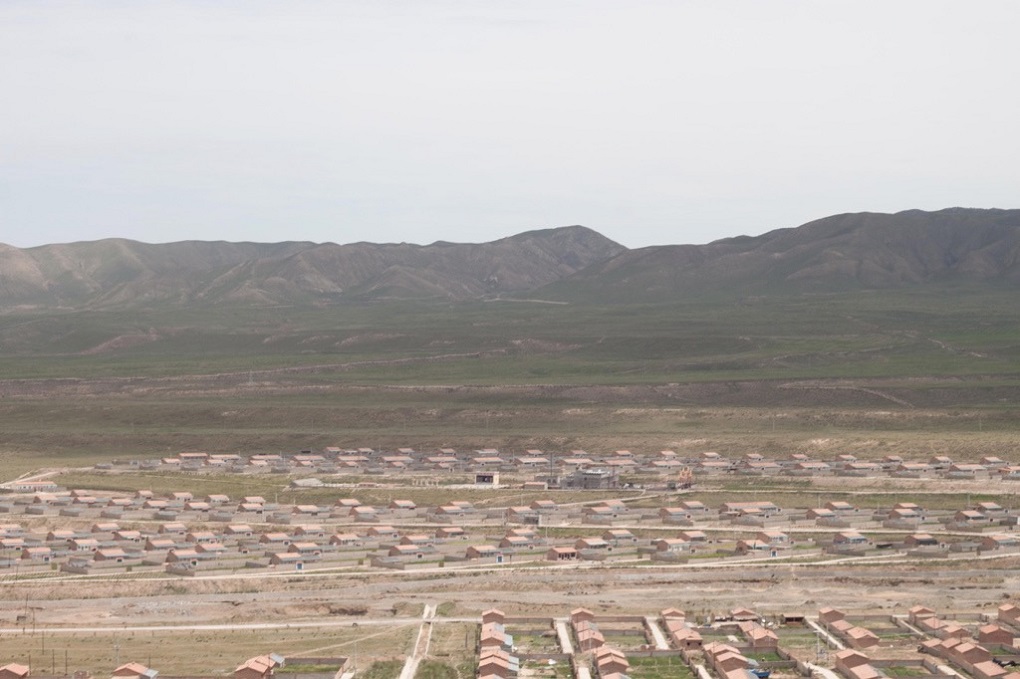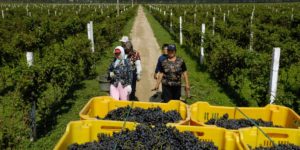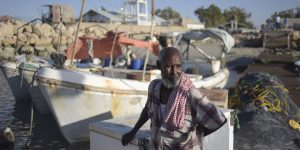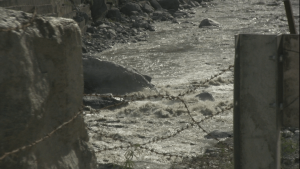In the summer of 2011 I travelled across the Tibetan plateau on a personal pilgrimage to Amne Machin, one of Tibet’s most sacred Buddhist mountains. On the way I passed through Henan county, a Mongolian autonomous region in China’s Qinghai province. This was a wild cowboy county on the windswept grasslands some 3,000 odd metres above sea level. I met nomads with gold teeth driving four by fours, grown rich on the lucrative caterpillar fungus trade. I hitched rides on trucks carrying two dozen Yaks to market. I saw the bleak resettlement villages, with hundreds of identical houses built in the middle of nowhere, where nomads were being moved as part of a government programme to conserve the grasslands.
For a large part of our journey we unwittingly found ourselves trailing the footsteps of China’s handpicked Panchen Lama, on a tour to whip up popular support. The Panchan Lama is the second most important religious figure in Tibet, and this boy, chosen by the Chinese Communist Party, was rejected by Tibetans who supported the herder’s son already anointed by the Dalai Lama. The heightened security around this figure made it hard for us as foreigners to find any hotel or guesthouse willing to take us in.
Since then, life in the Tibetan areas of western China have become even more restricted – a growing trend since the 2008 protests and the wave of self-immolations that followed. The tightening noose around Tibetans has also meant fewer outsiders have access to the region or understand the changes taking place here.
And so I was particularly glad to come upon a new collection of short stories by Tibetan writer Tsering Döndrup who comes from this area, expertly translated by Christopher Peacock.
Döndrup captures the daily life of nomads with dark satirical wit and undertones of simmering violence. He offers a bleak social critique on the environmental destruction and social disruption China’s rapid modernization has brought to the Tibetan plateau.

Döndrup is Tibet’s most well respected and popular writers, although he is actually ethnically Mongolian. He was born in the 1960s in Malho, (Henan in Mandarin), Qinghai, part of broader region known as Amdo to Tibetans spread over China’s northwest provinces of Qinghai and Gansu.
He started publishing in unofficial Tibetan journals as part of a wider literary movement that flourished as China opened up in the 1980s.
Growing up tending livestock, Döndrup had no formal schooling until the age of thirteen. But he went on to college and to become a teacher, legal secretary and editor of the Henan County Annals.
![The new cowboys of the Tibetan steppes [image by Beth Walker]](https://dialogue.earth/content/uploads/2019/02/The-new-cowboys-of-the-Tibetan-steppes.jpg)
Döndrup exposes major problems plaguing a rapidly changing Tibetan society of mahjong gambling, alcoholism and prostitution. He is sharply critical of the hypocrisy and corruption of Buddhism when it is practised badly. In one story an excessive alms giving campaign drives nomadic families into destitution.
He also presents a stinging attack of Chinese bureaucratic corruption, and more often the Tibetan officials who abuse their power. Corrupt official Lozang Gyatso tries to bribe his way out of death and avoid retribution for his worldly sins. He has embezzled money and national resources, stolen yaks and cheese from local people, weaselled his way through the party system, killed musk deer and endangered animals and even pissed into the mouths of revered monks.
Lost pastures
At the same time Döndrup captures the nomads’ strong connection with their land. These are small communities that herd their animals and survive on a diet of meat, butter, cheese and tsampa, against the backdrop of the rhythms of religious life.
It is clear that the disappearance of this traditional way of life goes hand in hand with the degradation of the environment sweeping this remote region.
One particularly poignant story “Black Fox Valley” follows a nomad Sangye and his family who are forced to sell their livestock and move to a newly built resettlement village as part of a government campaign to “return the pastures and restore the grasslands.”

There is one humorous account of the big porcelain toilet placed in every house. The family are horrified to discover what it’s for: “Pissing and crapping in a lovely basin like that? We’d use up so much merit our assholes would close up!” cries the Grandpa. When the local monk demonstrates its utility they find the toilet isn’t connected to the plumbing system and they have to clean up the holy detritus by hand.
But the wry humour turns sour. Sangye and his family struggle to adapt to their new lifestyle. Their belongings, even their dog, are stolen by thieves; they don’t get the financial compensation promised and struggle to buy basic food and goods of butter, milk and cheese and dung, cheated by shop owners.
While the younger family members adapt, learning Mandarin and going to school, the grandfather becomes more and more confused, thinking he still has to look after his animals, eventually succumbing to an early death.
The story unravels against a backdrop of the wider hazards of living in modern China. Fake milk is a menace – with the family finding the liquid diluted with water, yak milk passed off as cow milk or laced with antibiotics. The local school collapses in a minor earthquake, crushing children to a pulp – reminiscent of the horrors of the “tofu dreg” schools that collapsed in the 2008 Sichuan earthquake killing thousands of children. Water sources around the new village become so polluted even the pigs won’t drink from the streams.
At the end of the story the family return to their former valley, to find it has turned into an open coal mine. “The entire valley had been dug up and turned into an expanse of pitch black. Diggers, loaders, dump trucks and tractors scurrying like ants from a nest, a seething maelstrom of activity.”
In the name of conservation
Sangye and his family are one of hundreds of thousands of families who’ve been removed from the grasslands in China and rehoused in the name of environmental conservation over the past fifteen years.
This monumental lifestyle shift has had dire consequences for nomadic herders. Some experts also argue the government policy of resettlement has exacerbated grassland degradation, where large swathes of land – on an area that is the source of Asia’s major rivers – have turned into desert. There is also a body of evidence that shows moderate grazing is essential for maintaining grassland ecosystems and helps mitigate the impacts of climate change in a region scientists now say is warming three times the global average. The wide scale removal of nomads has also provided the opportune space for people to exploit the mineral and other resources of the Tibetan plateau.
Against this backdrop, Tsering Döndrup’s writing offers a unique window into the transformations taking place in Tibet. There are some Chinese translations of his work, according to Peacock, but most minority-language literature in China falls under the radar. And there are still few English translations of contemporary Tibetan literature, so this is a very welcome addition to a fascinating field.
Hopefully in the future Döndrup and other Tibetan writers will find a wider platform for their work in China and beyond.
![<p>Amne Machin, a sacred mountain on the Tibetan plateau, which is changing far quicker than the world realises [image by: Joshua Cohen]</p>](https://dialogue.earth/content/uploads/2019/02/The-Tibetan-plateau-is-changing-far-quicker-than-the-world-realises.jpg)




![Fears of river diversion have led to protests against a Chinese funded hydropower project in Kashmir [image by: Ghulam Rasool]](https://dialogue.earth/content/uploads/2019/03/Neelum1-Ghulam-Rasool-300x200.jpg)



